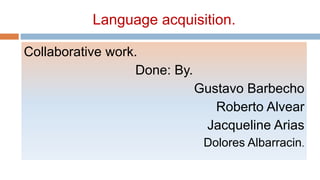
Language acquisition
- 1. Language acquisition. Collaborative work. Done: By. Gustavo Barbecho Roberto Alvear Jacqueline Arias Dolores Albarracin.
- 2. COMPETENCE AND USE It is everything that a speaker needs to know in order to communicate Linguistic competence Knowledge of the specific components and levels of a language It is required for their appropriate use in communicative activities Pragmatic competence. Interpret and convey meaning within communicative situations The effects their use of language has on other participants in the act of communication”
- 3. Academic competence and interpersonal competence Priorities for L2 use Interpersonal competence encompasses knowledge required of learners the L2 primarily in face-to-face contact with other speakers. Academic competence include the knowledge needed by learners who want to use the L2 primarily to learn occupational field.
- 4. Components of language knowledge Vocabulary (lexicon) Phonology (sound system) Syntax (grammar) Morphology (word structure) Discourse (connect sentences and organize information)
- 5. Components of Language. Vocabulary (how words are used) Morphology (how words are structured) Phonology (how words are pronounced) Syntax (the correct use of grammar) Discourse (how someone connects ideas and words)
- 6. Vocabulary is the most difficult component to achieve. Vocabulary is also known as lexicon. The main part of Vocabulary are the function words. Other important words are idioms, metaphors and collocations. Morphology teaches you how words are made, for example antiabortion, is made of anti (against) and abortion, so this word means against abortion, this procedure is called derivational morphology, means adding prefixes and suffixes to create words. Morphology requires knowing the different parts of words. Phonology was the most important part for mastering English. Phonemes are related with the meaning of
- 7. Syntaxis. Involves learning the correct use of words, rules, functions of words and their uses. They change the structure in different languages, so an analysis and a study has to be made. Discourse. Is based on sequential indicators, logical connectors, among others for cohesion. An important part also are genres and interactional strategies.
- 8. RECEPTIVEACTIVITES Reading Important transfer of knowledge & ability L1 to L2 No matter how different writing symbol system is Beginning L2 Reading If writing symbols are far different (Chinese -English), 1º recognize them Progress depends on prior knowledge learner has Academic Reading Extract detailed information in any subject. Pre-requisites: Vocabulary recognition Complex sentences structure and punctuation Focused elements Old & new information Text structure Information organization
- 9. RECEPTIVEACTIVITES Listening Information Processing Input: notice cues Central Processing: Bottom up/ Top down factors Beginning L2 Listening Process: segment speech stream into meaningful units: sounds to words → phrases → sentences Academic Listening Pre-requisites: Vocabulary recognition Ability to process native & non native varieties Reciprocal & non reciprocal practices help “ear tuning” (Saville-Troike, 2006) Extensive exposure to oral and academic texts.
- 10. PRODUCTIVE ACTIVITES Writing Is the most important productive activity for L2 learners to develop Writing is a common medium for testing knowledge Beginning L2 writing Once enrolled in programs, such students must complete papers and other written assignments for many of their classes, and essay examinations Graduate degrees usually require writing extended texts Speaking in conjunction with listening is a very important area of activity for L2 learners Involved in bottom-up processes Features of pronunciation Grammatical patterns coherence within a conversation